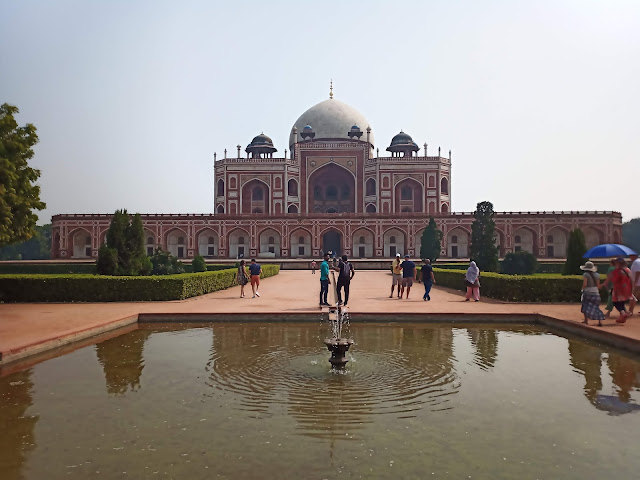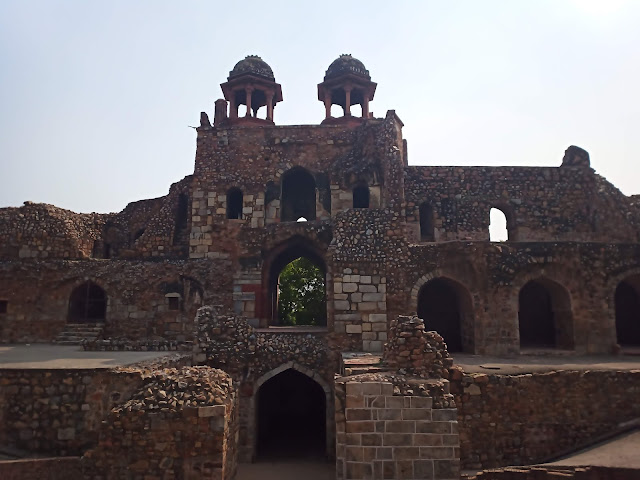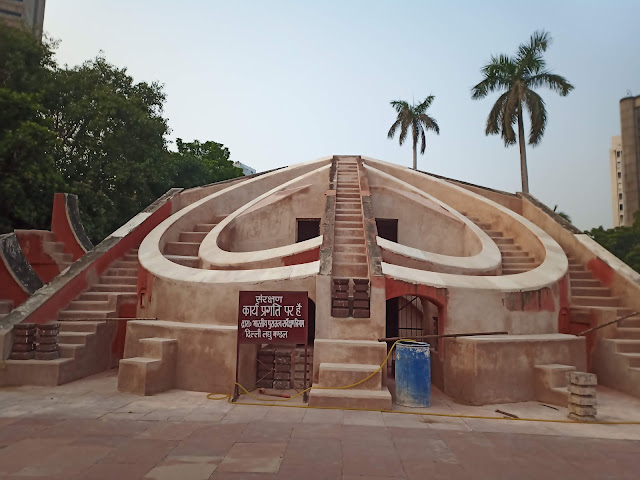An Archaeologist's Guide to Delhi, India
This October I have been on a research trip to India for my PhD. In addition to the work I've been doing here for my thesis, I have been taking the opportunity for sight seeing. India has a rich and diverse history, which is still palpable in the country today. As the capital and second most populous city in India, Delhi is a representation of the country as a whole.
National Museum
Delhi National Museum is located in New Delhi, the part of Delhi established by the British as the administrative and governance capital of India. The National Museum sits between Rashtrapati Bhavan, the president's residence which includes its own museum, and the iconic India Gate.The National Museum is open on Tuesday to Sunday from 10am to 6pm. As with many museums and historical sites in India, Indian nationals are charged a fraction of the price of foreigners for entry. The foreigner ticket is 650 rupees (about 13 AUD or 9 USD), including an audio guide.
The New Delhi National Museum covers India's history from the Stone Age to the historic period. Galleries are dedicated to the Harappans, Mauryans, Guptas, medieval art, Buddhism, paintings, and a range of aspects of Indian culture that have continued into the contemporary period, including decorative arts, jewellery and textiles.
My research focus in archaeology is the Bronze Age, with my thesis covering the Indus Valley or Harappan civilisation, which was based in Pakistan and northwestern India in the 3rd to 2nd millennium BCE. Accordingly, the museum's Harappan gallery was of particular interest to me.
Featured in the Harappan gallery are a range of Indus stamp seals, which depict images and writing in the undeciphered Indus script. Stamp seals were used to impress the pattern on the seal into a soft substance such as clay or wax, transferring a mirror image of the seal onto this surface. They were often used for authorising transactions or securing doors or cargo for travel.
The lighting in the museum wasn't the best for taking photos so here is a slightly blurry photo of some stamp seals and their impressions.
There is also a good collection of bronze and stone artefacts, and pottery and terracotta figurines. Here is a reconstruction of a Harappan burial from the site of Rakhigarhi, which was interesting to see.
The collections at the National Museum demonstrate a great diversity and progression in art and history in the Indian subcontinent, with the audio guide providing useful context to each gallery. A trip to the museum while in Delhi is definitely worthwhile to gain a broad understanding of the history of India and see a range of exciting artefacts.
Old Delhi
Old Delhi, also known as Purani Dilli, is the historical component of the city of Delhi, which was a walled town established by the Mughal dynasty after the emperor Shah Jahan moved the capital of India from Agra (the site of the Taj Mahal), to Delhi in 1639. The city was initially named Shahjahanabad after the emperor.
This area of the city contains historical architecture dating from the Mughal period, as well as Chandni Chowk, Old Delhi's shopping area which has been around for more than three hundred years. Chandni Chowk is full of narrow winding laneways and colourful markets selling spices, teas, clothes, wedding jewellery and all manner of other things. For a foreigner, Chandni Chowk can be both wonderful and overwhelming at the same time, with thousands of people crowding the cramped streets and packing into the small market stalls.
Tourists should keep in mind that you will be approached by many rickshaw drivers who will offer to show you Chandni Chowk from the comfort of their bumpy vehicles. This can be a more pleasant option than trying to navigate the twisting and uneven streets on your own, but be aware that the rickshaw driver will no doubt take you on a lengthy tour and then demand a heavily inflated price (my rickshaw driver asked me for 20 000 to 30 000 rupees, which is about 400-600 AUD or 300-400 USD). Remember that you don't have to pay them this extortionate price!
Red Fort
The Red Fort, or Lal Qila, is probably the most famous attraction in Old Delhi and has been given UNESCO world heritage status. True to its name, the fort was constructed from red sandstone under order emperor from Shah Jahan in 1638. In 1752, after Mughal power weakened, the Marathas took over rule of Delhi and control of the building. At the Battle of Delhi in 1803, part of the Second Anglo-Maratha War in India, the British East India Company forces defeated the Marathas, and control of the Red Fort was in British hands.
Following independence from the British, the first prime minister of India, Jawaharlal Nehru, raised the flag of India at the fort on 15 August 1947. Since then and continuing to today, the prime minister of India visits the Red Fort on each Independence Day, raises the flag and gives a nationally televised speech to the country.
Following independence from the British, the first prime minister of India, Jawaharlal Nehru, raised the flag of India at the fort on 15 August 1947. Since then and continuing to today, the prime minister of India visits the Red Fort on each Independence Day, raises the flag and gives a nationally televised speech to the country.
The Red Fort is open to visitors from sunrise to sunset, Tuesday to Sunday, with entry for foreigners costing 500 rupees (about 10 AUD or 7 USD). Every evening sound and light shows take place from 6pm, for an extra 80 rupees for adults or 30 rupees for children.
Jama Masjid
Delhi's Jama Masjid, also known as Masjid e Jahan Numa ("World-reflecting mosque") was completed in 1656 and was also built by Shah Jahan as part of the emperor's construction scheme for his new city. This is one of the largest mosques in India, built of red sandstone and marble, and visitors are required to climb up a large steep staircase to reach the mosque. Visitors must remove footwear at the top of the stairs, and then can enter in to the large courtyard area in front of the mosque. Due to its status as a tourist attraction, female visitors are not required to wear headscarves in order to enter the mosque area, as is usually customary. Still, visitors should wear clothes that cover their legs, upper arms and body.
Humayun's Tomb
Humayun's Tomb is a grand tomb complex constructed in 1570. The architecture of the tomb was new in many ways, being the first garden tomb complex built in the Indian subcontinent. The site is inscribed on the UNESCO World Heritage List and displays novel architectural features that influenced the construction of other monumental buildings in India, most notably the Taj Mahal.
Humayun was the second Mughal emperor and upon his death this tomb was commissioned by his first wife. The main tomb building for Humayun also has the tombs of his first wife and many other Mughals.
In addition to this main tomb, the grounds also house the tomb of Isa Khan Niyazi, who was an Afghan nobleman serving the Suri Dynasty. This tomb was constructed in 1547. Lush green gardens surround the main buildings within the tomb complex.
The tomb complex is open daily from sunrise to sunset, costing foreigners 500 rupees (about 10 AUD or 7 USD).
Purana Qila
Purana Qila, translating to "Old Fort", is a large red sandstone fortress in Delhi. As the name implies, this site has been continuously occupied for 2500 years. The fort which you can see when you visit the site today was constructed by emperor Humayun in the 16th century and completed by his successor Sher Shah Suri, who founded the Suri empire in northern India. A moat originally surrounded the fort, with a paved bridge providing access to the main gate.
The Purana Qila complex consists of a range of buildings, including a mosque, a castle, and a hammam (bathhouse).
Interestingly, according to the sign accompanying the below structure, this building was used by Humayun as a library. The sign said that upon hearing the call to prayer one day, Humayun rushed down the stairs from the top floor of the building, and fell down the stairs, resulting in injuries that later killed him. That is how the Mughal emperor Humayun ended up in his magnificent tomb complex above.
Another interesting fact is that this site has often been identified as Indraprastha, which is the capital of the kingdoms of the Pandava family from the Mahabharata, an ancient Indian Sanskrit epic.
Purana Qila is open daily from sunrise to sunset, and costs 200 rupees for foreigners (about 4 AUD or 3 USD). The site is located quite close to Humayun's tomb, and a short auto ride from one to the other will let you see both in the same morning or afternoon.
Jantar Mantar
Jantar Mantar in New Delhi is an observatory housing a collection of thirteen large-scale astronomical instruments built by Maharaja Jai Singh II of Jaipur in 1724. There are five other Jantar Mantar sites around India, at Jaipur, Ujjain, Mathura and Varanasi. "Jantar" is based on the Sanskrit word "yantra" which means "instrument", and "Mantar" comes from "mantra" which translates to "formula".
The instruments within the New Delhi complex include a giant sundial, measuring devices for the altitude of stars based on the longtitude and latitude of the earth, and another device for determining the shortest and longest days of the year. These instruments provide an insight into the scientific capabilities of their builders.
The entry fee for foreigners is 100 rupee (about 2 AUD or 1.50 USD), and the site is open daily from sunrise to sunset. Its location in central New Delhi and intriguing architecture make it well worth a visit.
Qutub Minar
Qutub Minar is the name of the minaret located within the Qutub complex in south Delhi. The minaret is 73 metres tall, and the most eyecatching part of the archaeological site, which is inscribed on the UNESO World Heritage List. The construction of the minaret began around the year 1200, with various rulers adding sections to it over time, counteracting damage that occurred to the tower from earthquakes throughout the years.
Walking through the Qutub complex, there are ruins and remains of a
number of mosques, tombs and other buildings, with columns and pillars
littering the site, reminiscent of other iconic ancient sites like the Forum
in Rome.
This unfortunate structure seen below was destined to be a minaret even taller than Qutub Minar, but was never built beyond this height.
The Qutub complex is open daily, costing 500 rupees for foreigners (about 10 AUD or 7 USD). Despite being further away than most attractions in Delhi, it is an astounding site to visit. You'll need to go and see the sheer scale of the Qutub Minar minaret yourself.
Temples
Lotus Temple
One of the major tourist attractions in Delhi is the Lotus Temple, a house of worship of the Baha'i faith. The temple is open to all visitors, and like most religious buildings in India, visitors are required to go through a security check and remove their shoes before entry to the building. The temple is situated within a large grounds, filled with lush green foliage, and visitors are led along a long paved path leading to the temple.
Being a Sydneysider, the temple reminded me a bit of the Sydney Opera House, with its pointed white architecture shining in the hot Delhi sun.
Underneath the temple are pools of water, which bring a sense of coolness and calm to the outside of the temple. After visiting the temple (no photography allowed inside), many visitors sit by one of the pools for a break from the heat.
The Lotus Temple opened in 1986, and since then has welcomed millions of visitors. The Baha'i faith espouses unity and equality of all peoples. Although the religion originated in Persia, India now has the largest following of Baha'i devotees in the world.
Across from the temple is an information centre that displays the history of the Baha'i faith and its development around the world.
Akshardham
Akshardham, also known as the Swaminarayan Akshardham complex, is a Hindu temple complex that opened in Delhi in 2005. The grounds of the complex house abundant, verdant gardens that are perfectly maintained, surrounding the main temple. The complex was constructed by the Bochasanwasi Akshar Purushottam Sanstha (BAPS) religious organisation.
Visitors must check all their belongings (except for wallets/ small purses) into the cloak room, including mobile phones, before entering the temple complex. Photography inside the complex is strictly prohibited. As a result, this very zoomed and blurry photo was all I could get of the temple.
After checking in their possessions, guests walk along a long walkway surrounded by rich foliage, leading to the monumental temple itself. As with all temples, guest are required to remove footwear before ascending the marble and sandstone staircase to enter the temple itself. White marble has been strategically placed on the approaching path and the stairs to provide respite for visitors' bare feet from the hot red sandstone that absorbs the heat of the Delhi sun.
Here is an image from Wikimedia that shows the temple much better than my photo.
 |
| By Kapil.xerox - Own work, CC BY-SA 4.0, https://commons.wikimedia.org/w/index.php?curid=39493915 |
The inside of the temple is richly decorated with gold, marble and ornate carvings, fostering a resounding sense of spirtuality that all visitors will feel, regardless of their religious predilections. There is also a canteen serving vegetarian food on site, as well as a gift shop toting all manner of Hindu religious items and Ayurvedic remedies.
I particularly recommend visiting temples and religious sites when in Delhi. The religious architecture provides an oasis of ornateness amongst the overwhelming hustle of Delhi as a city. It is at these temples that visitors truly have the opportunity to take in the site and its significance without being harassed by scammers and the like, who you will find in most tourist locations throughout the city.
The richness of design and storytelling capacity of humans is also showcased at these active religious sites. Their peace and serenity permeates visitors, the cool floors and quiet atmosphere providing respite from the heat, humidity and noise of the outside world and soothing visitors from their feet up.
Archaeological Survey of India
Archaeological sites in India are managed by the Archaeological Survey of India (ASI), an agency of the Indian Ministry of Culture. This institute was established by Alexander Cunningham in 1861 who served as the first Director-General. Following liberation from the British, the organisation has increasingly served an important role in Indian culture, historical ownership and self determination, administering archaeological research, conservation and preservation of cultural monuments.
I visited the ASI building in Delhi as part of my time there; below are some photos of the impressive government building.
In Summary
What I particularly noticed during my archaeological explorations of Delhi was that the ASI monuments in India are being well maintained and preserved as legacies of Indian culture. The cheap entry prices for Indians (usually 25 rupee, about 0.50 AUD or 0.35 USD) is a big drawing card for locals to visit the sites, and I saw young couples and youth hanging out on the well-kept lawns and among the archaeological ruins across the city.
These historic places have become a present day haven for youth to relax and take in the gardens and greenery with their friends and partners, away from the chaos and density of Dehli. In this way the old and the new intermingle in this busy historical and modern hub.






























Small correction - Jantar Mantar in Delhi and the larger Jantar Mantar in Jaipur, Rajasthan display the scientific temperament and fervour of the Rajputs - Hindu kings and rulers from the rustic lands of Rajasthan and not of the Mughals. There are also some architectural jewels lying hidden within the modern city like the Bawli or old heritage water well with ornate architecture and sculpture carvings that provide respite from the unnerving heat of Delhi.
ReplyDeleteQuite a thorough coverage of the historical wonders and monuments that exist cheek-by-jowl with the modern city of Delhi. Well written.
ReplyDelete